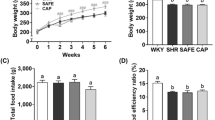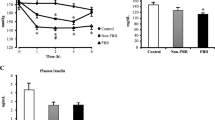Abstract
Rice bran hydrolysates contain highly nutritional proteins and beneficial phytochemicals. Sang-Yod rice bran hydrolysates (SRH) extracted from red pigmented rice is a rich source of nutrients and phenolic compounds. The present study evaluated the antihypertensive effect of SRH and its safety in Sprague-Dawley rats. Hypertension was induced in male rats by administration of L-NAME (50 mg/kg/day) in drinking water for three weeks, and the antihypertensive effect of SRH was evaluated. Treatment of SRH (250 or 500 mg/kg) significantly reduced arterial blood pressure and improved hemodynamic parameters. The antihypertensive effect was associated with decreased oxidative stress, suppressed p47phox NADPH oxidase expression, increased nitric oxide bioavailability and decreased angiotensin II level and ACE activity. The SRH was shown to be safe after feeding male and female rats with a rodent diet containing 1.5% SRH for 90 days. Overall, these findings suggest that SRH is safe and may help to prevent hypertension.




Similar content being viewed by others
References
Sharif MK, Butt MS, Anjum FM, Khan SH (2014) Rice bran: a novel functional ingredient. Crit Rev Food Sci Nutr 54:807–816. https://doi.org/10.1080/10408398.2011.608586
Park HY, Lee KW, Choi HD (2017) Rice bran constituents: immunomodulatory and therapeutic activities. Food Funct 8:935–943. https://doi.org/10.1039/c6fo01763k
Boonla O, Kukongviriyapan U, Pakdeechote P, Kukongviriyapan V, Pannangpetch P, Thawornchinsombut S (2015) Peptides-derived from Thai rice bran improves endothelial function in 2K-1C renovascular hypertensive rats. Nutrients 7:5783–5799. https://doi.org/10.3390/nu7075252
Boonloh K, Kukongviriyapan V, Kongyingyoes B, Kukongviriyapan U, Thawornchinsombut S, Pannangpetch P (2015) Rice bran protein hydrolysates improve insulin resistance and decrease pro-inflammatory cytokine gene expression in rats fed a high carbohydrate-high fat diet. Nutrients 7:6313–6329. https://doi.org/10.3390/nu7085292
Senaphan K, Sangartit W, Pakdeechote P, Kukongviriyapan V, Pannangpetch P, Thawornchinsombut S, Greenwald SE, Kukongviriyapan U (2018) Rice bran protein hydrolysates reduce arterial stiffening, vascular remodeling and oxidative stress in rats fed a high-carbohydrate and high-fat diet. Eur J Nutr 57:219–230. https://doi.org/10.1007/s00394-016-1311-0
Zhang H, Wang J, Liu Y, Gong L, Sun B (2016) Rice bran proteins and their hydrolysates modulate cholesterol metabolism in mice on hypercholesterolemic diets. Food Funct 7:2747–2753. https://doi.org/10.1039/c6fo00044d
Huang YP, Lai HM (2016) Bioactive compounds and antioxidative activity of colored rice bran. J Food Drug Anal 24:564–574. https://doi.org/10.1016/j.jfda.2016.01.004
Min B, McClung AM, Chen MH (2011) Phytochemicals and antioxidant capacities in rice brans of different color. J Food Sci 76:C117–C126. https://doi.org/10.1111/j.1750-3841.2010.01929.x
Srisawat U, Panunto W, Kaendee N, Tanuchit S, Itharat A, Lerdvuthisopon N, Hansakul P (2010) Determination of phenolic compounds, flavonoids, and antioxidant activities in water extracts of Thai red and white rice cultivars. J Med Assoc Thail 93(Suppl 7):S83–S91
Phantuwong N, Thongraung C, Yupanqui CT (2017) Enzymatic hydrolysis on protein and β-glucan content of sang-yod rice bran hydrolysates and their anti-inflammatory activity on RAW 264.7 cells. FFHD 7:958–971 https://ffhdj.com/index.php/ffhd/article/view/388
NCD Risk Factor Collaboration (2017) Worldwide trends in blood pressure from 1975 to 2015: a pooled analysis of 1479 population-based measurement studies with 19.1 million participants. Lancet 389:37–55. https://doi.org/10.1016/S0140-6736(16)31919-5
Pinciroli M, Aphalo P, Nardo AE, Anon MC, Quiroga AV (2019) Broken rice as a potential functional ingredient with inhibitory activity of renin and angiotensin-converting enzyme(ACE). Plant Foods Hum Nutr 74:405–413. https://doi.org/10.1007/s11130-019-00754-6
Kukongviriyapan U, Luangaram S, Leekhaosoong K, Kukongviriyapan V, Preeprame S (2007) Antioxidant and vascular protective activities of Cratoxylum formosum, Syzygium gratum and Limnophila aromatica. Biol Pharm Bull 30:661–666. https://doi.org/10.1248/bpb.30.661
OECD. (2018) Test No. 408: Repeated Dose 90-Day Oral Toxicity Study in Rodents, OECD Guidelines for the Testing of Chemicals Adopted:25 June 2018. OECD Publishing, Paris. https://doi.org/10.1787/20745788
Vauzour D, Rodriguez-Mateos A, Corona G, Oruna-Concha MJ, Spencer JP (2010) Polyphenols and human health: prevention of disease and mechanisms of action. Nutrients 2:1106–1131. https://doi.org/10.3390/nu2111106
Sarikonda KV, Watson RE, Opara OC, Dipette DJ (2009) Experimental animal models of hypertension. J Am Soc Hypertens 3:158–165. https://doi.org/10.1016/j.jash.2009.02.003
Touyz RM (2004) Reactive oxygen species, vascular oxidative stress, and redox signaling in hypertension: what is the clinical significance? Hypertension 44:248–252. https://doi.org/10.1161/01.HYP.0000138070.47616.9d
Torok J (2008) Participation of nitric oxide in different models of experimental hypertension. Physiol Res 57:813–825
Drummond GR, Selemidis S, Griendling KK, Sobey CG (2011) Combating oxidative stress in vascular disease: NADPH oxidases as therapeutic targets. Nat Rev Drug Discov 10:453–471. https://doi.org/10.1038/nrd3403
Justo ML, Candiracci M, Dantas AP, de Sotomayor MA, Parrado J, Vila E, Herrera MD, Rodriguez-Rodriguez R (2013) Rice bran enzymatic extract restores endothelial function and vascular contractility in obese rats by reducing vascular inflammation and oxidative stress. J Nutr Biochem 24:1453–1461. https://doi.org/10.1016/j.jnutbio.2012.12.004
Schmieder RE, Hilgers KF, Schlaich MP, Schmidt BM (2007) Renin-angiotensin system and cardiovascular risk. Lancet 369:1208–1219. https://doi.org/10.1016/S0140-6736(07)60242-6
Akinyemi AJ, Thome GR, Morsch VM, Stefanello N, Goularte JF, Bello-Klein A, Oboh G et al (2015) Effect of dietary supplementation of ginger and turmeric rhizomes on angiotensin-1 converting enzyme (ACE) and arginase activities in L-NAME induced hypertensive rats. J Funct Foods 17:792–801. https://doi.org/10.1016/j.jff.2015.06.011
Zanchi A, Schaad NC, Osterheld MC, Grouzmann E, Nussberger J, Brunner HR, Waeber B (1995) Effects of chronic NO synthase inhibition in rats on renin-angiotensin system and sympathetic nervous system. Am J Phys 268:H2267–H2273. https://doi.org/10.1152/ajpheart.1995.268.6.H2267
Ardiansyah SH, Koseki T, Ohinata K, Hashizume K, Komai M (2006) Rice bran fractions improve blood pressure, lipid profile, and glucose metabolism in stroke-prone spontaneously hypertensive rats. J Agric Food Chem 54:1914–1920. https://doi.org/10.1021/jf052561l
Shobako N, Ogawa Y, Ishikado A, Harada K, Kobayashi E, Suido H, Kusakari T et al (2018) A novel antihypertensive peptide identified in thermolysin-digested rice bran. Mol Nutr Food Res 62:1700732. https://doi.org/10.1002/mnfr.201700732
Acknowledgements
This research was supported by the Khon Kaen University Research Grants [No. 6100049, No.6200037], and the National Research Council of Thailand (NRCT) and the Agricultural Research Development Agency (ARDA) under the Thailand Research Organization Network (TRON; CRP5507020810), Thailand. We would like to thank Dr. Justin Thomas Reese for editing the manuscript via the Publication Clinic KKU, Thailand.
Author information
Authors and Affiliations
Corresponding author
Ethics declarations
Conflict of Interest
The authors declare that they have no conflict of interest.
Additional information
Publisher’s Note
Springer Nature remains neutral with regard to jurisdictional claims in published maps and institutional affiliations.
Electronic supplementary material
ESM 1
(DOCX 216 kb)
Rights and permissions
About this article
Cite this article
Jan-on, G., Sangartit, W., Pakdeechote, P. et al. Antihypertensive Effect and Safety Evaluation of Rice Bran Hydrolysates from Sang-Yod Rice. Plant Foods Hum Nutr 75, 89–95 (2020). https://doi.org/10.1007/s11130-019-00789-9
Published:
Issue Date:
DOI: https://doi.org/10.1007/s11130-019-00789-9




